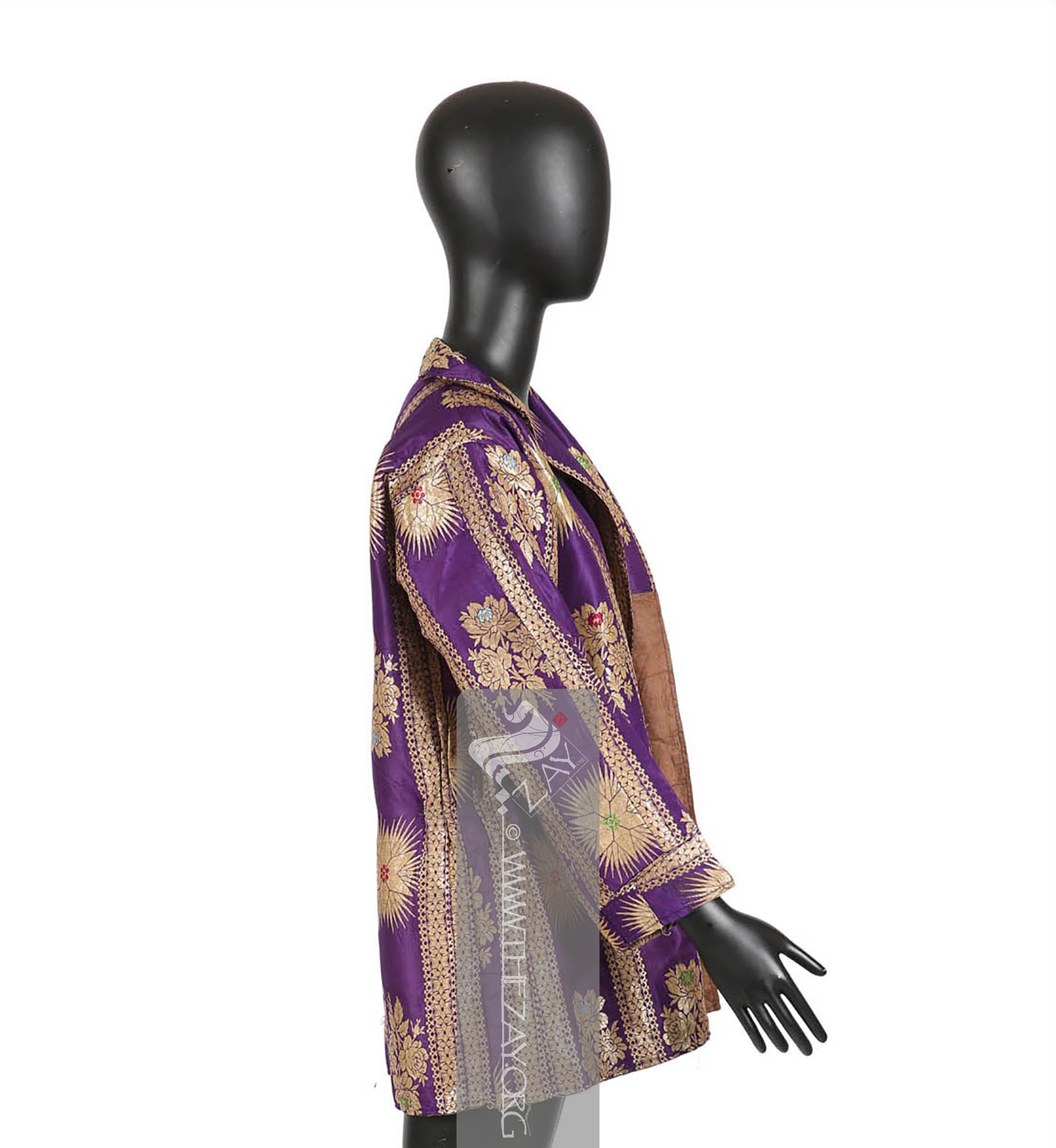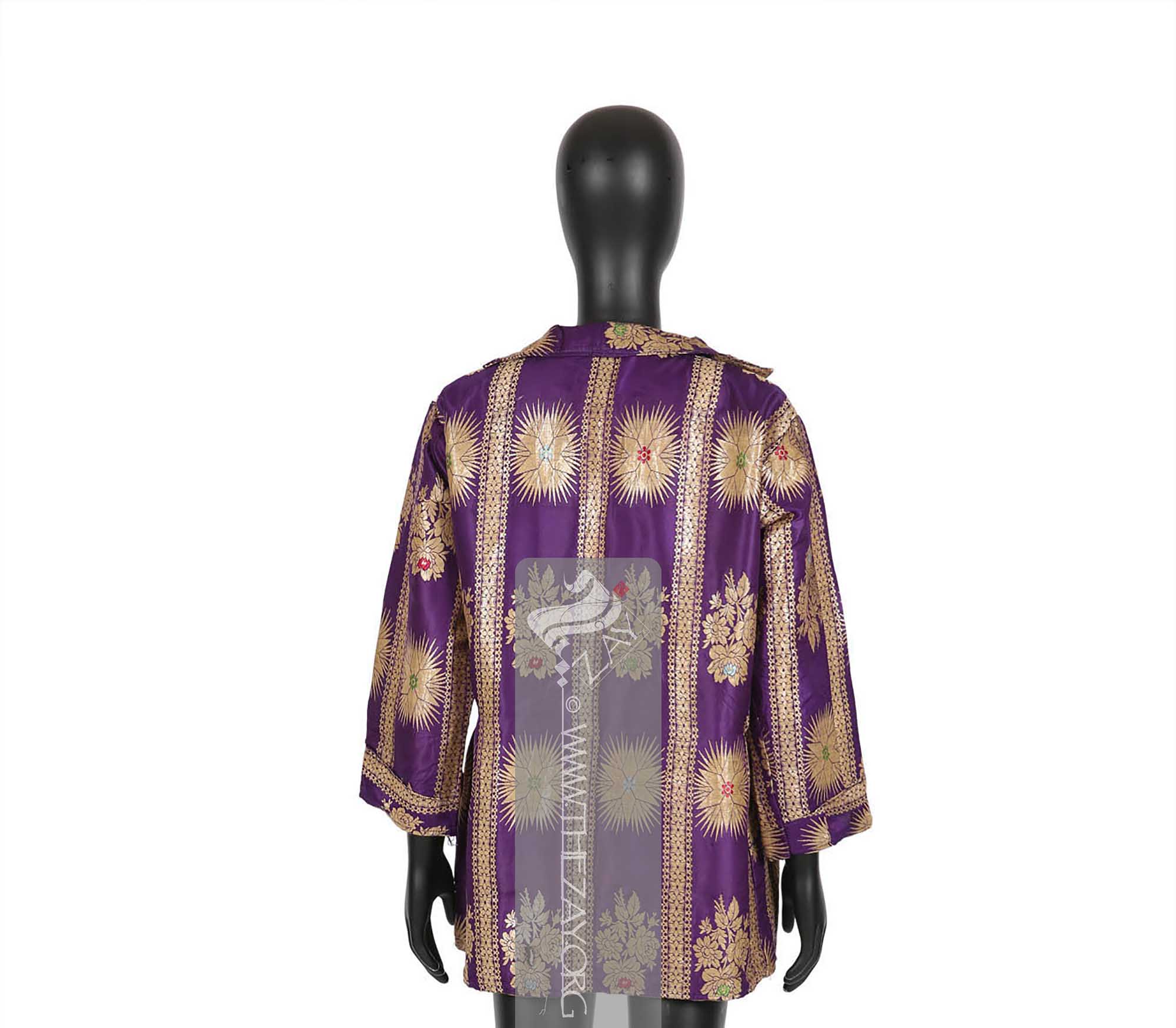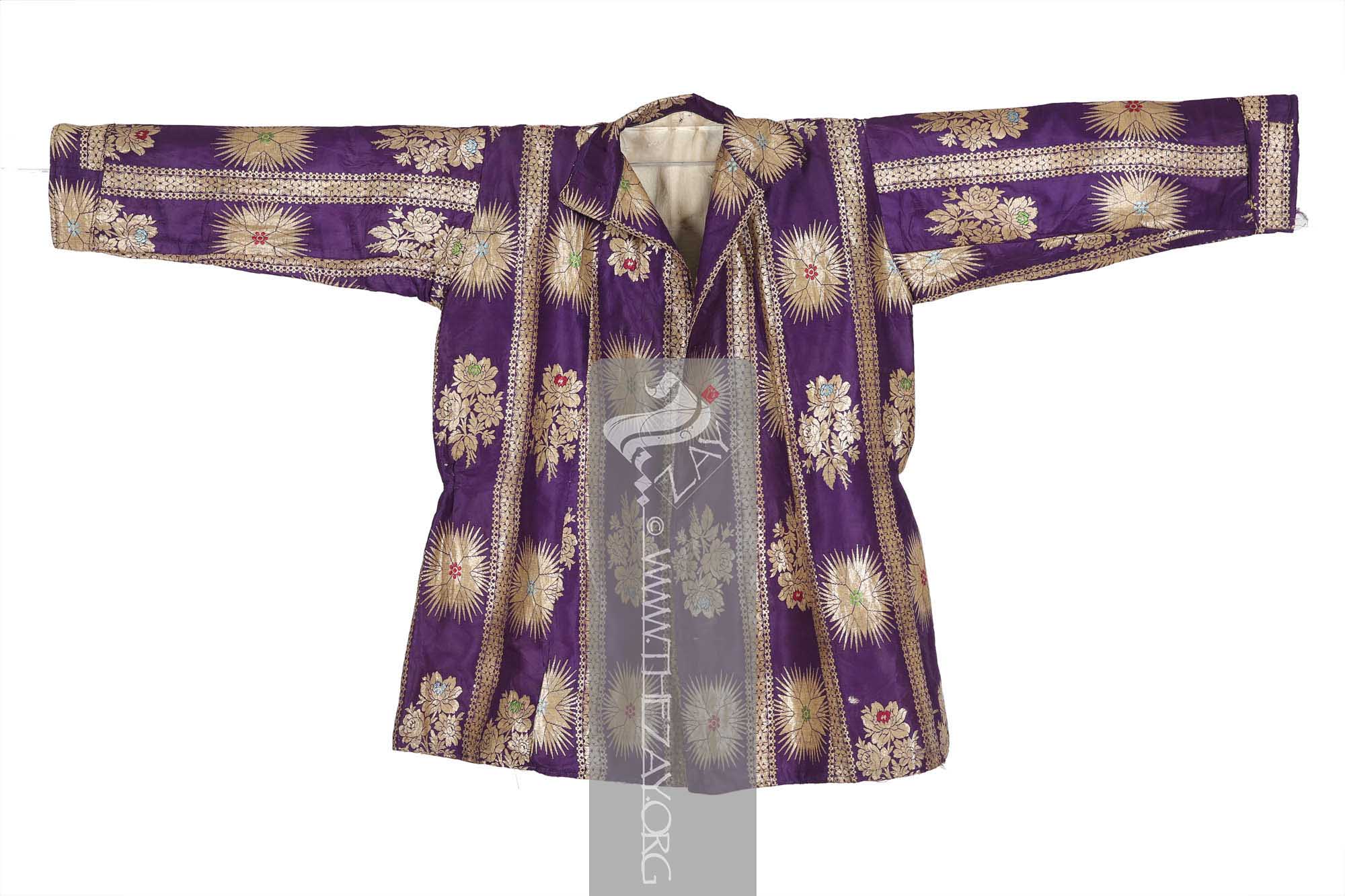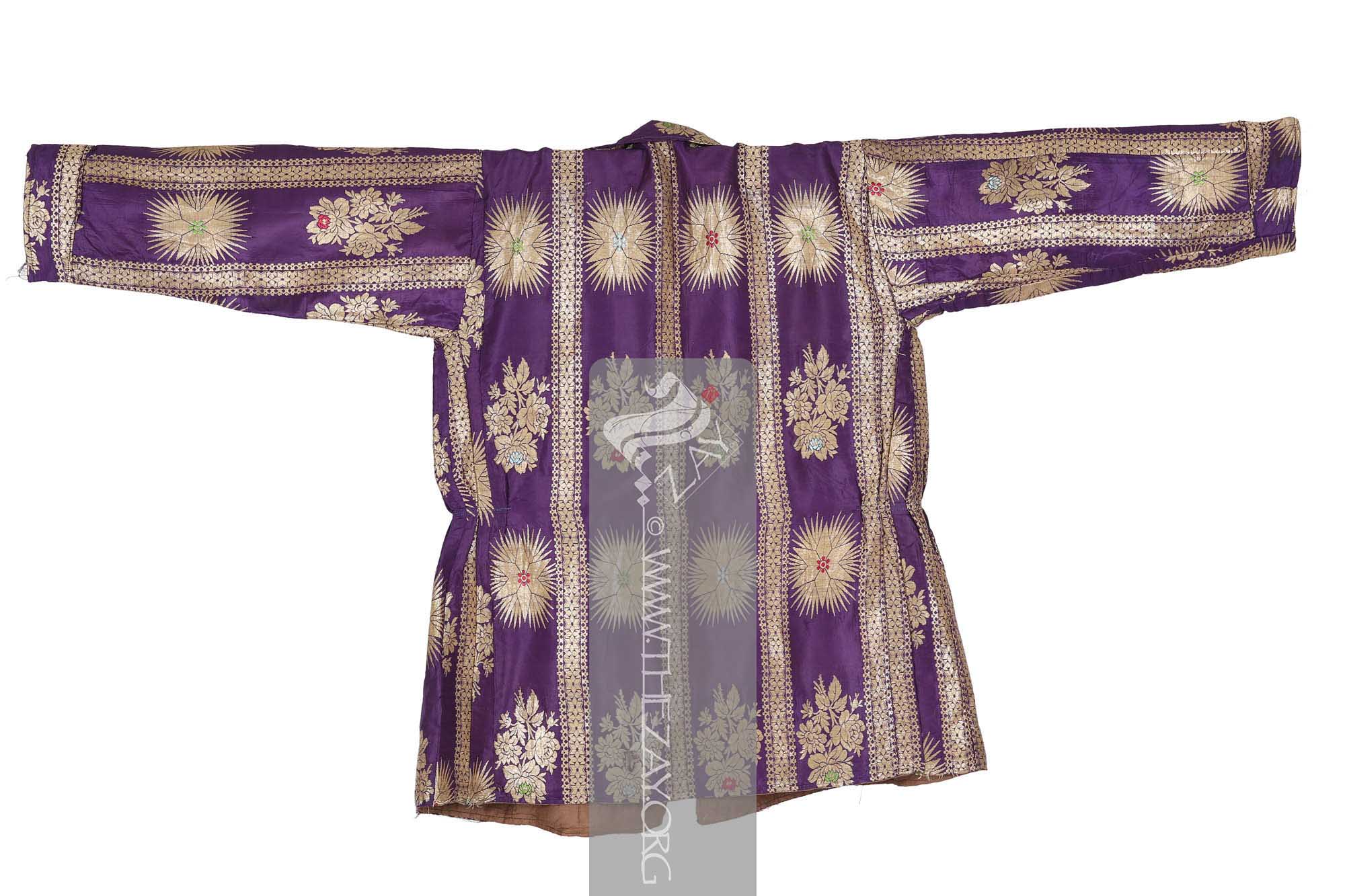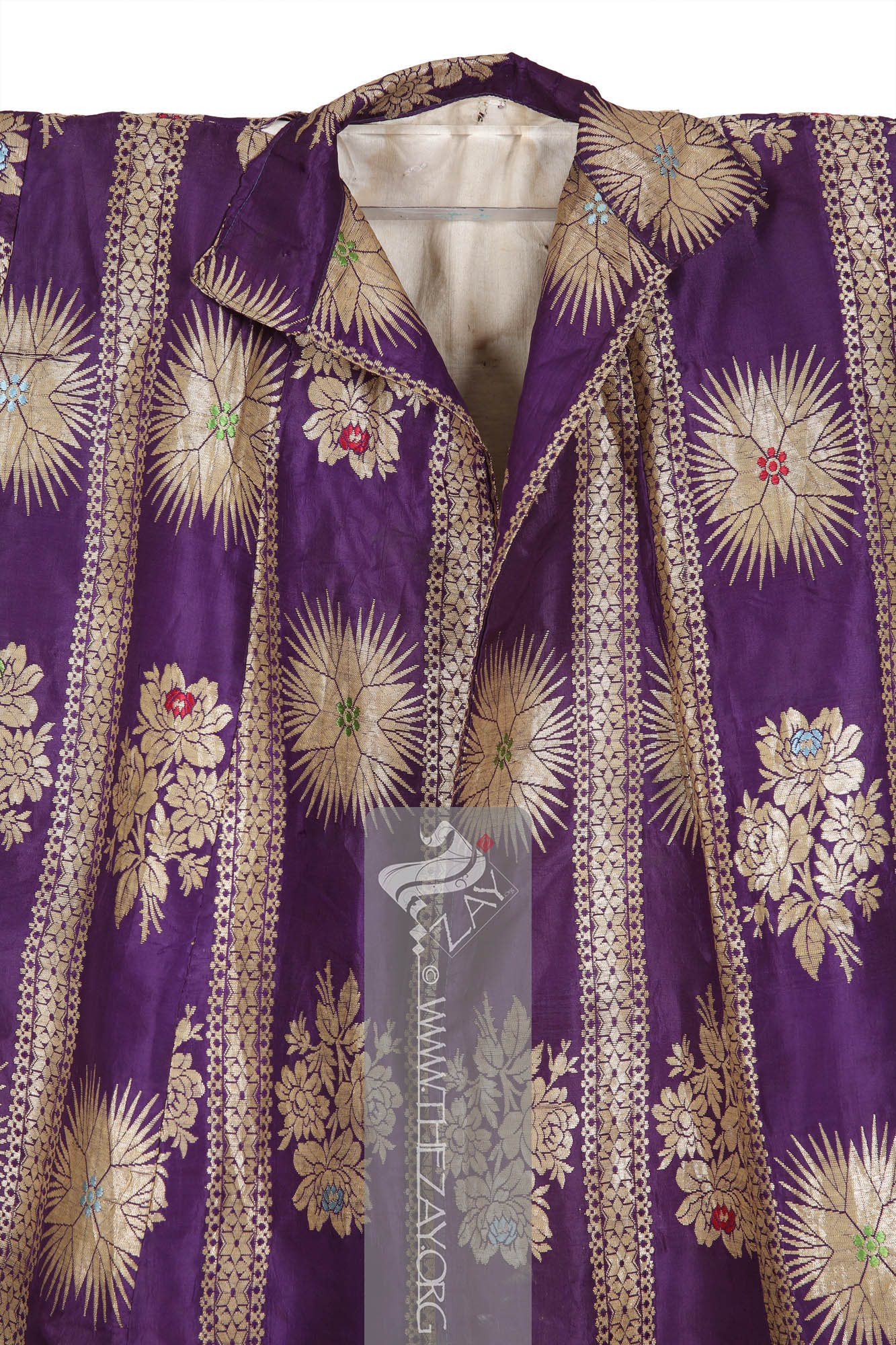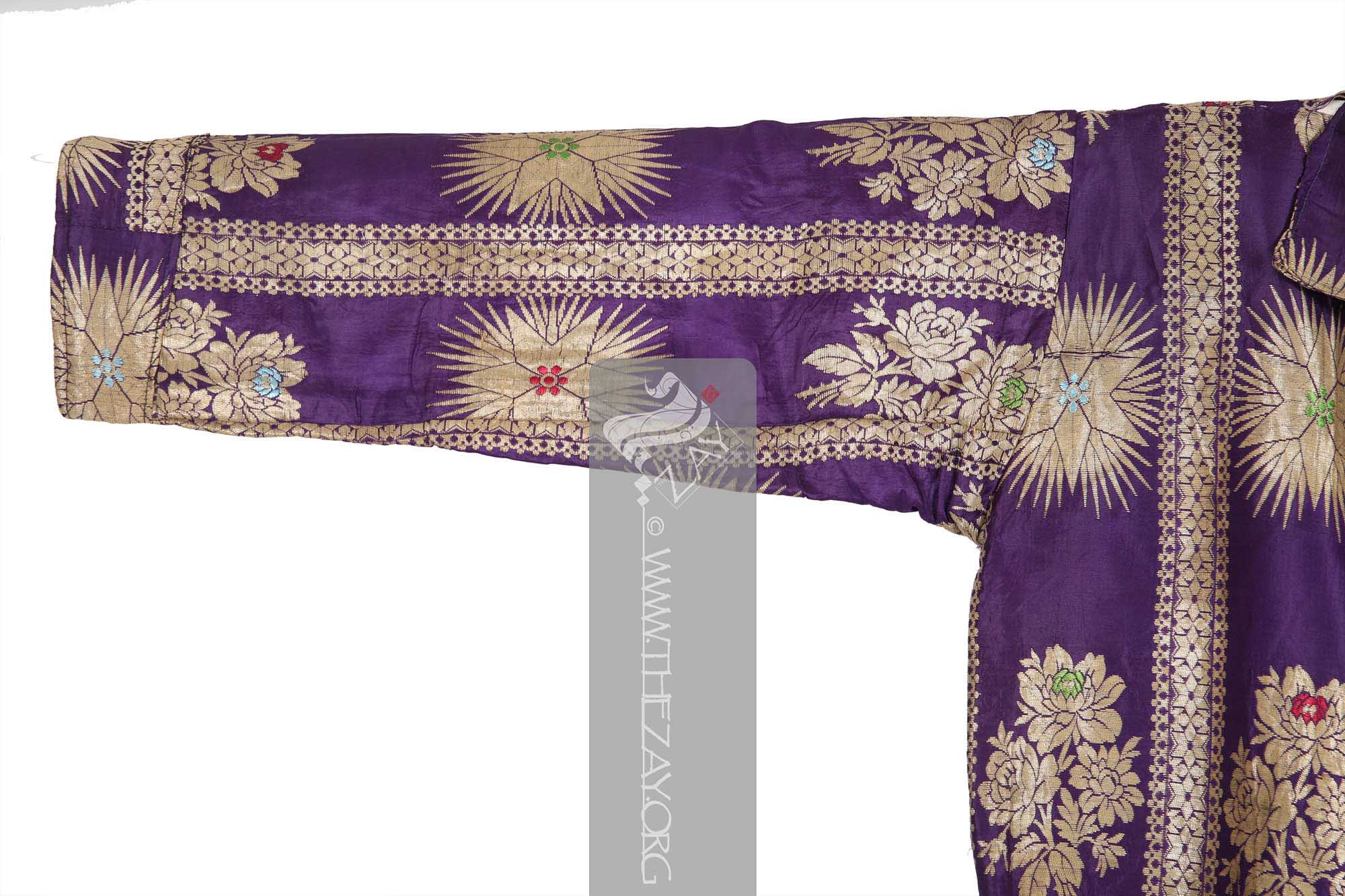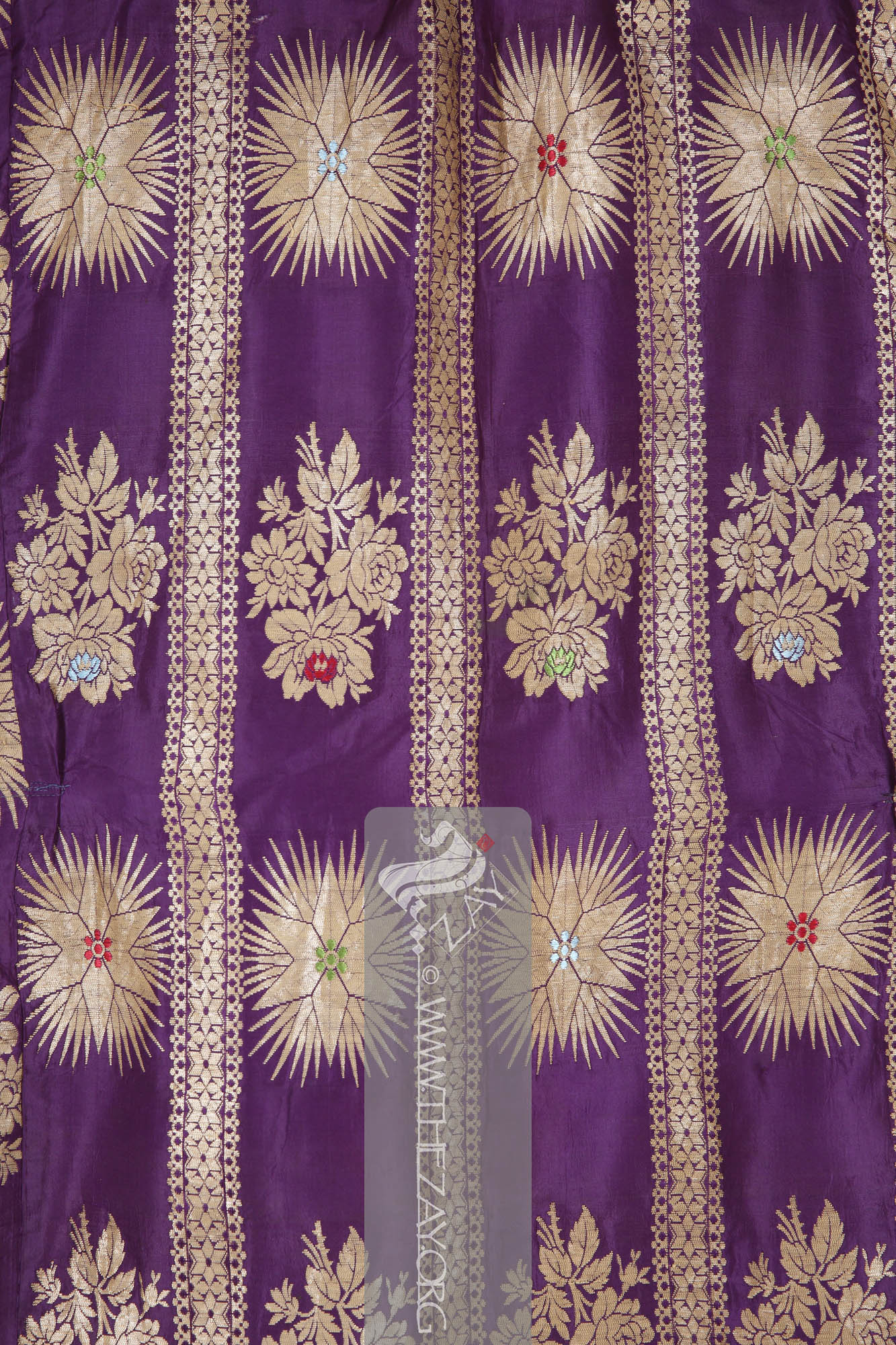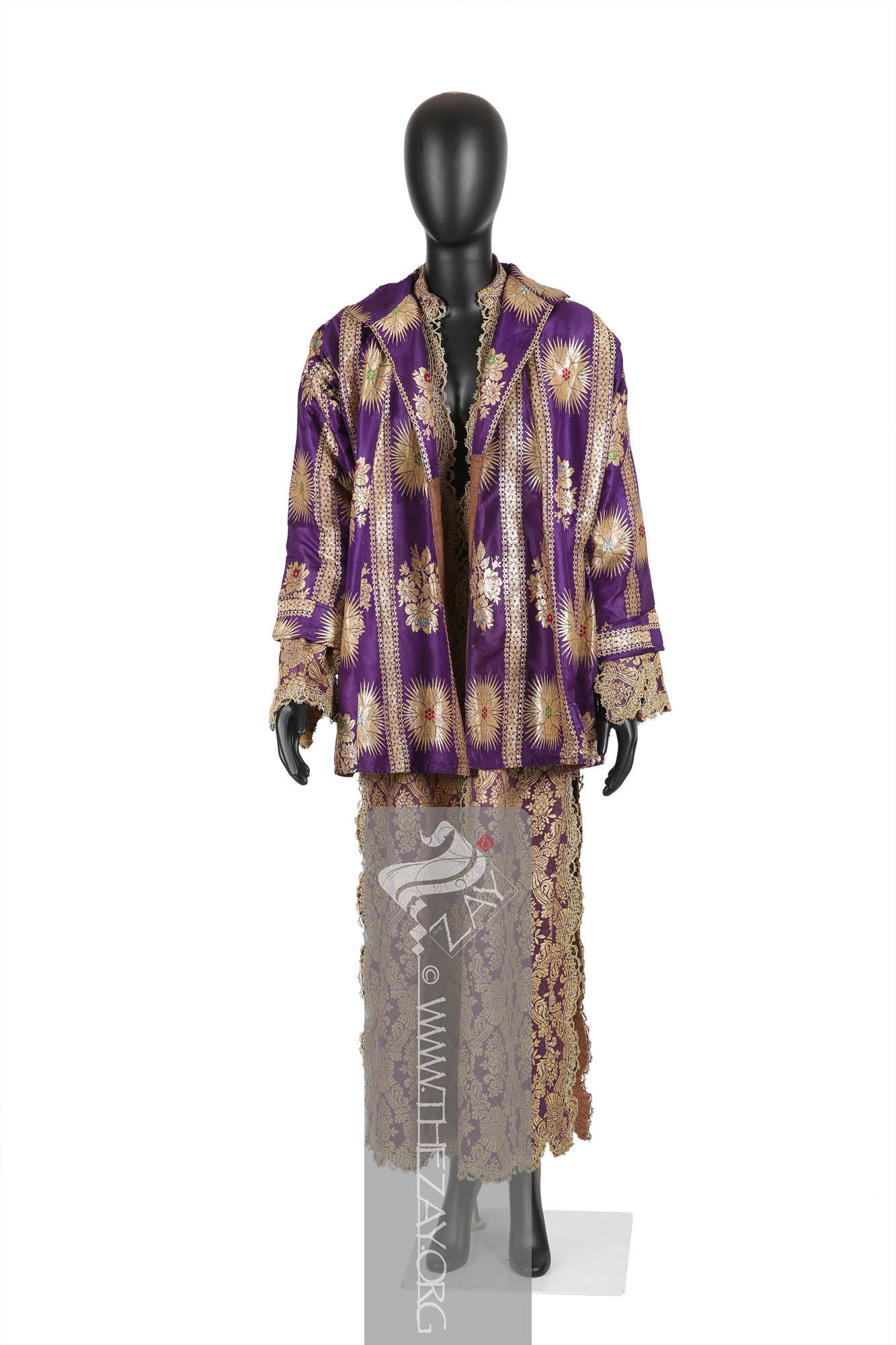Object NotePart of a lot possibly from the same ensembles with one more item (
ZI2019.500645 ASIA).
Object History This piece of garment was purchased by
Dr. Reem Tariq
Ṭariq: (Arabic; Synonym: tulle_bi_talli
Tūlle_bi_tallī: (French: Tulle – a city in France where fine material for veil was first made; Turkish: tel – wire; Synonym: tariq; talli; badla; khus_dozi ), series of small metal knots made on a woven net ground as embellishment. The term is commonly used in the North African Arab region specifically in Egypt.
; talli; badla; khus_dozi ), series of small metal knots made on a woven net ground as embellishment. The term is commonly used in the Levant Arab region specifically in Lebanon.
El Mutwalli
Dr. Reem Tariq
Ṭariq: (Arabic; Synonym: tulle_bi_talli
Tūlle_bi_tallī: (French: Tulle – a city in France where fine material for veil was first made; Turkish: tel – wire; Synonym: tariq; talli; badla; khus_dozi ), series of small metal knots made on a woven net ground as embellishment. The term is commonly used in the North African Arab region specifically in Egypt.
; talli; badla; khus_dozi ), series of small metal knots made on a woven net ground as embellishment. The term is commonly used in the Levant Arab region specifically in Lebanon.
el Mutwallī: Founder (CEO) of the Zay
Zay: (Arabic: costume, Pl. azyaā’), a set of clothes in a style typical of a particular country or historical period. Initiative, a public figure, speaker and author. An expert curator and consultant in Islamic art and architecture, interior design, historic costume, and UAE heritage. from
Kerry Taylor Auctions, London in 2019 to add to and enhance The
Zay
Zay: (Arabic: costume, Pl. azyaā’), a set of clothes in a style typical of a particular country or historical period. Initiative Collection.
Object Features This is a purple silk
brocade
Brocade: (Italian: brocco – twisted thread), is a richly decorative fabric woven with an intricate raised pattern. Its origins can be traced back to ancient China, where it was made for the imperial court. It later spread to Europe during the Renaissance and became popular in couture and decorative arts. hip-length jacket (
zibin
Zībin: (Turkish), a hip length shirt like traditional jacket with varied sleeve lengths worn by Ottoman women as an overgarment which could be layered by a kaftan if required. ) for women featuring a pinched waist giving it a peplum effect beneath the hips, long sleeves and
collar with lapels.
The field of the jacket displays a repeat of two different floral motifs arranged alternately. While one is a large star-shaped motif resembling a spangled mirror (
aynali_pullu
Aynāli_pullu: (Turkish: Ayna – mirror), decorative motif that looks like a mirror with rays of light around it. ) with a tiny flower in the centre in coloured silk
floss
Floss: (Old French: flosche – nap of velvet), is a type of silk fibre obtained from the cocoons of wild silkworms. It is characterized by its long, fluffy fibers that are not tightly woven, making it ideal for use in various textile applications such as embroidery, lace-making, and sewing. thread, the other is a rose bouquet with coloured highlights in
floss
Floss: (Old French: flosche – nap of velvet), is a type of silk fibre obtained from the cocoons of wild silkworms. It is characterized by its long, fluffy fibers that are not tightly woven, making it ideal for use in various textile applications such as embroidery, lace-making, and sewing..
The silk
floss
Floss: (Old French: flosche – nap of velvet), is a type of silk fibre obtained from the cocoons of wild silkworms. It is characterized by its long, fluffy fibers that are not tightly woven, making it ideal for use in various textile applications such as embroidery, lace-making, and sewing. used for highlights is in green, pink and light blue colours. The repeat motifs are arranged in vertical panels separated by rows of geometric star-shaped repeats running parallel. The field of the piece is lined with an ivory cotton fabric and strips of brown cotton along the edges.
The collar is lined with the same purple
brocade
Brocade: (Italian: brocco – twisted thread), is a richly decorative fabric woven with an intricate raised pattern. Its origins can be traced back to ancient China, where it was made for the imperial court. It later spread to Europe during the Renaissance and became popular in couture and decorative arts. with wide panels on the underside of the plackets. The sleeves are loose but tapering and narrow at the cuffs. The lining is heavily stained, and the main fabric has frayed and torn in places.
Interestingly, in parts of the Arab world, especially the Levant and the adjacent Fertile Crescent region an (
entari
: (Turkish; Synonym: Antari), a traditional Turkish long jacket-like unisex garment worn during the Ottoman era. It often featured an open front with long sleeves and was worn over an undershirt and a pair of trousers and was sometimes layered by a short waist or hip-length jacket. ) like front open long jacket generally worn by men is called the (
zubun
Zubūn: (Turkish: zibin – a type of jacket, synonyms: sayah, qumbāz, gombaz, yalak), long front open, unlined, lightweight silk traditional cloak either with a quarter or no sleeves fastened at the waist often worn by both men and women in the Levant, Fertile Crescent, and Najd regions.
). It could have been possible that the term possibly a derivative of the Turkish word
zibin
Zībin: (Turkish), a hip length shirt like traditional jacket with varied sleeve lengths worn by Ottoman women as an overgarment which could be layered by a kaftan if required. was assigned to a different garment perhaps inspired by the
entari
: (Turkish; Synonym: Antari), a traditional Turkish long jacket-like unisex garment worn during the Ottoman era. It often featured an open front with long sleeves and was worn over an undershirt and a pair of trousers and was sometimes layered by a short waist or hip-length jacket. .
Another possibility is that during its nascent years of popularity, the
entari
: (Turkish; Synonym: Antari), a traditional Turkish long jacket-like unisex garment worn during the Ottoman era. It often featured an open front with long sleeves and was worn over an undershirt and a pair of trousers and was sometimes layered by a short waist or hip-length jacket. and the
zibin
Zībin: (Turkish), a hip length shirt like traditional jacket with varied sleeve lengths worn by Ottoman women as an overgarment which could be layered by a kaftan if required. almost always looked alike except for their slight difference in length – a fashion that was adopted evenly across the empire even the Arab regions. It is possible that while in Turkish parlance, the
zibin
Zībin: (Turkish), a hip length shirt like traditional jacket with varied sleeve lengths worn by Ottoman women as an overgarment which could be layered by a kaftan if required. evolved into something much shorter, in the Arab regions it remained the same long garment from its time of inception.
At its peak, the Ottoman Empire spanned three continents and served as the crossroads between the East and the West – the Fertile Crescent, the Levant, Eastern Europe including the Balkans till the southern edge of the Great Hungarian Plain, Northern Africa and Eastern Mediterranean.
After the conquest of the Arab world in c. 1516-1517 CE its control over the Middle East lasted for four centuries until the early 20th century with the onset of WW I and the Arab Revolt. These four hundred years witnessed many instances of mutual Arab and Ottoman cultural influences and exchanges. Through areas such as social life and art – decorative and performing –we come across several instances of Arab and Turkish culture blending together through the centuries.
Just as European fashion was often inspired by the French court this socio-cultural blending between Ottoman Turkey and the Middle East was clearly reflected in its fashion and material culture.
Thus, while emulating Ottoman fashion as the mark of class in the Arab world was one side of the puzzle adapting Eastern European fashion particularly Balkan as part of mainstream couture culture because of the sizable Balkan population within the Empire was another. Therefore, it is not surprising to find several articles of clothing and their terms similar between the two cultures.
Links
- Cangökçe, Hadiye, et al. Osmanlı İmparatorluğu’nun Son Döneminden Kadın Giysileri = Women’s Costume of the Late Ottoman Era from the Sadberk Hanım Museum Collection. Sadberk Hanım Museum, 2010.
- Küçükerman, Önder, and Joyce Matthews. The Industrial Heritage of Costume Design in Turkey. GSD Foreign Trade Co. Inc, 1996.
- AĞAÇ, Saliha, and Serap DENGİN. “The Investigation in Terms of Design Component of Ottoman Women Entari
: (Turkish; Synonym: Antari), a traditional Turkish long jacket-like unisex garment worn during the Ottoman era. It often featured an open front with long sleeves and was worn over an undershirt and a pair of trousers and was sometimes layered by a short waist or hip-length jacket. in 19th Century and Early 20th Century.” International Journal of Science Culture and Sport (IntJSCS), vol. 3, no. 1, Mar. 2015, pp. 113–125. https://dergipark.org.tr/tr/download/article-file/91778
- Parker, Julianne. “OTTOMAN AND EUROPEAN INFLUENCE IN THE NINTEENTH-CENTURY BRIDAL COLLECTION OF THE AZEM PALACE, DAMASCUS, SYRIA.” Journal of Undergraduate Research: Brigham Young University, 18 Sept. 2013. http://jur.byu.edu/?p=6014
- Koç, Adem. “The Significance and Compatibility of the Traditional Clothing-Finery Culture of Women in Kutahya in Terms of Sustainability.” Milli Folklor, vol. 12, no. 93, Apr. 2012. 184. https://www.millifolklor.com/PdfViewer.aspx?Sayi=93&Sayfa=181
- Micklewright, Nancy. “Late-Nineteenth-Century Ottoman Wedding Costumes as Indicators of Social Change.” Muqarnas, vol. 6, 1989, pp. 161–74. JSTOR, https://doi.org/10.2307/1602288. Accessed 13 July 2023.
- Micklewright, Nancy. “Looking at the Pst: Nineteenth-Century Images of Constantinople and Historic Documents.” Expedition, vol. 32, no. 1, pp. 24–32. https://www.penn.museum/documents/publications/expedition/pdfs/32-1/micklewright.pdf
- Ozgen, Ozlen, et al. “Henna Ritual Clothing in Anatolia from Past to Present: An Evaluation on Bindalli.” Textile Society of America Symposium Proceedings, 2021, https://doi.org/10.32873/unl.dc.tsasp.0122.
- Denny, Walter B., and Sumru Belger Krody. The Sultan’s Garden: The Blossoming of Ottoman Art. The Textile Museum, 2012. https://museum.gwu.edu/sites/g/files/zaxdzs3226/f/Sultans%20Garden%20Catalogue.pdf
- Ersoy, Ayla. Traditional Turkish Arts. Ministry of Culture and Tourism Publications, 2008. https://teda.ktb.gov.tr/Eklenti/6593,traditionalturkishartspdf.pdf?0
- https://www.metmuseum.org/art/collection/search/451160
- https://collections.vam.ac.uk/item/O90892/entari
: (Turkish; Synonym: Antari), a traditional Turkish long jacket-like unisex garment worn during the Ottoman era. It often featured an open front with long sleeves and was worn over an undershirt and a pair of trousers and was sometimes layered by a short waist or hip-length jacket. -unknown/
- https://www.metmuseum.org/art/collection/search/85546
- https://www.metmuseum.org/art/collection/search/85540
- https://islamicart.museumwnf.org
- https://www-kutahya-gov-tr.translate.goog/geleneksel-giysi
- https://archive.aramcoworld.com/issue/200703/the.skill.of.the.two.hands.htm
- http://www.turkishculture.org/textile-arts/clothing/womens-garments/womens-garments
- http://jezebeljane.blogspot.com/2015/09/womens-clothing-in-16th-century-turkey
- https://www.issendai.com/16thcenturyistanbul/visual-dictionary/kaftan/
- https://babogenglish.wordpress.com/2016/02/25/turkey-general-information/
- https://ertugrulforever.com/turkish-fashion-2021/
- https://northamericaten.com/turkish-clothing-of-ottoman-times/
- https://www.al-monitor.com/originals/2019/04/turkish-traditional-costumes-from-head-to-toe





